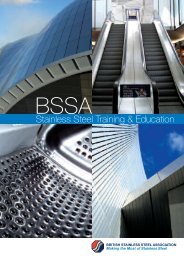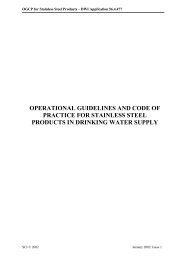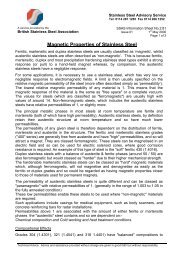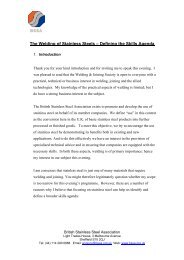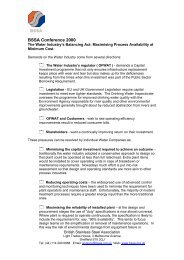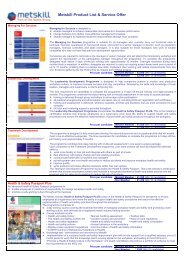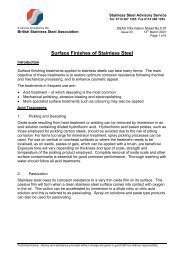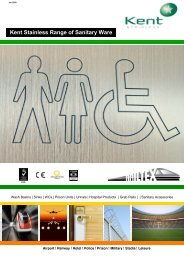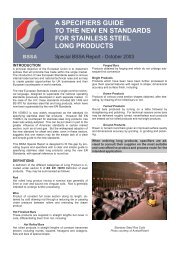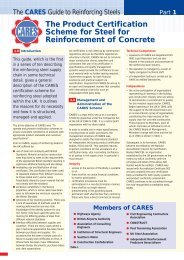The energy benefit of stainless steel recycling - British Stainless ...
The energy benefit of stainless steel recycling - British Stainless ...
The energy benefit of stainless steel recycling - British Stainless ...
You also want an ePaper? Increase the reach of your titles
YUMPU automatically turns print PDFs into web optimized ePapers that Google loves.
ARTICLE IN PRESS<br />
J. Johnson et al. / Energy Policy ] (]]]]) ]]]–]]] 3<br />
Fig. 1. (a) System boundary diagram for the <strong>stainless</strong>-<strong>steel</strong> life cycle; (b) <strong>energy</strong> used for the production <strong>of</strong> ferrochromium, representative <strong>of</strong> Outokumpu<br />
processes.<br />
requiring adequate scrap availability), while the Virgin<br />
Production scenario assumes no scrap <strong>recycling</strong>. <strong>The</strong> scrap<br />
that is utilized in Current Operations and Maximum<br />
Recycling can be prompt scrap (internal to the process),<br />
new scrap from industrial processes, or old scrap for postconsumer<br />
discards. Any and all <strong>of</strong> these forms are used to<br />
meet scrap requirements. Although the primary units <strong>of</strong><br />
chromium are predominately in the form <strong>of</strong> ferrochromium<br />
and primary iron is assumed to come from direct reduced<br />
iron (DRI), primary nickel may come from ferronickel,<br />
refined nickel, or nickel oxide sinter. <strong>The</strong> share <strong>of</strong> primary<br />
nickel used for <strong>stainless</strong>-<strong>steel</strong> production was assumed<br />
to be 30%, 65%, and 5%, respectively, for each <strong>of</strong><br />
these forms.<br />
<strong>The</strong> indirect (or ‘‘hidden’’) <strong>energy</strong> use throughout the life<br />
cycle makes a significant contribution to total <strong>energy</strong> use.<br />
To capture as much <strong>of</strong> this indirect <strong>energy</strong> use as possible,<br />
the following factors were included in the system boundary:<br />
(1) the <strong>energy</strong> used in electricity production; (2) the<br />
<strong>energy</strong> used in the acquisition and production <strong>of</strong> fuels; and<br />
(3) intermediate good transportation by ship, rail, and<br />
truck. <strong>The</strong>re are other indirect <strong>energy</strong> use factors that, for<br />
tractability, were not included in this study. To assess the<br />
magnitude <strong>of</strong> these other factors, economic input–output<br />
life-cycle assessment (EIO-LCA) was employed. (Carnegie<br />
Mellon University Green Design Institute, 2007) <strong>The</strong><br />
categories that are included in this study (e.g., ‘‘ferroalloy<br />
and related product manufacturing’’) account for 87% <strong>of</strong><br />
Please cite this article as: Johnson, J., et al., <strong>The</strong> <strong>energy</strong> <strong>benefit</strong> <strong>of</strong> <strong>stainless</strong> <strong>steel</strong> <strong>recycling</strong>. Energy Policy (2007), doi:10.1016/j.enpol.2007.08.028



